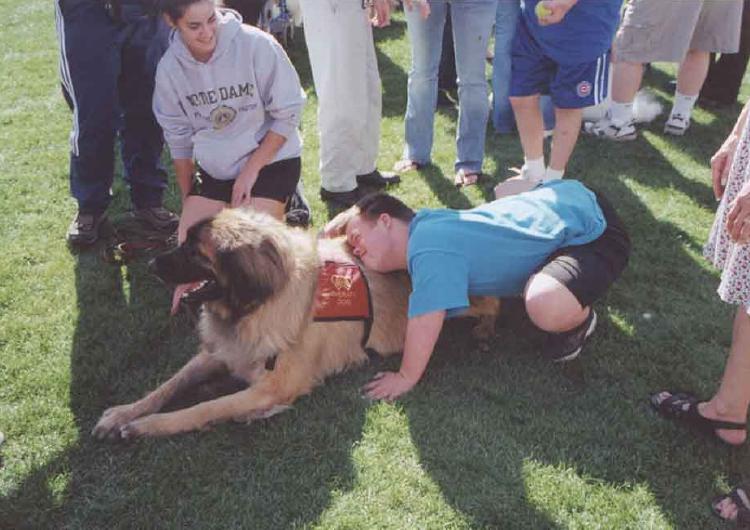|
Leonbergers At Work Ė Therapy Work A wide range of human health professionals and practitioners recognize what many people in the animal care giving field and everyday pet owners have known for years; namely, that pets can be good for our health and well being. Within the past couple of decades in particular, companion animals are being introduced into the therapeutic regimens of many health care institutions: nursing homes, hospitals, rehabilitation centers, psychiatric institutions and others. Therapeutic riding programs improve the motor skills and coordination of the physically challenged. Pets help juvenile offenders and inmates in correctional facilities to learn empathy and compassion. Autistic children swim with dolphins. In short, wherever people have special needs, someone with creativity and an animal with the proper temperament can probably create an imaginative way to bring pets and people together for mutual benefit.
Hannah von Drevas, TD1, CGC ("Hannah") Scientific research has shown that a hospital patientís interaction with an animal can provide positive and emotional benefits. It can reduce stress levels and invoke a sense of well being. Animal assisted therapy also acts as a catalyst to motivate patients to help themselves. For example, a child will happily take a dog for a walk, or throw the animal a ball, forgetting the pain for a little while and thereby improving their mood and interactions with family and staff. In other arenas, troubled youngsters can respond to animals in ways that they often canít to people. In many cases, the child, perhaps for the first time, experiences companionship, intimacy and a sense of inclusion and self-worth. Seen through a childís eyes, an animal-friend is non-judgmental. The child perceives other benefits as well, such as unquestioned loyalty, physical contact and returned affection. It is not uncommon for at-risk children to feel depressed, withdrawn and even unwanted. In order for the healing process to begin, they need to feel connected and to experience a personal bond with another living thing. For some children, connecting with an adult or peer may be perceived as threatening. In such cases, an animal-friend becomes a logical alternative.
The pet also makes it easier for two strangers to talk. It gives people a common interest and provides a focus for conversation. Many people in hospitals or group homes have had to give up pet ownership and they miss the casual acceptance a pet gives them. A dog pays little attention to age or physical ability, but accepts people as they are. The benefits continue even after the visit, as it leaves behind memories not only of the visit, but of past experiences, thereby offering something for people to share. Given the requirements for animals considered suitable for this type of work, the Leonbergerís temperament and stoic personality make them ideal candidates. If you think your Leo would be suitable for visiting nursing homes, hospitals, and other facilities, your first step is to get it certified by one of the national organizations, such as Therapy Dogs International [link] and to complete the Canine Good Neighbour test. For more information on how to find an evaluator in your area please visit the Canadian Kennel Club on-line [link].
REALITY CHECK : As a general rule, taking a course and/or getting you and your pet certified will not lead to employment opportunities. They will, however, expand your horizons, introduce you to an incredible network of pets and people with similar beliefs, and open the doors to exciting volunteer and research opportunities.
For additional information on Therapy Work with your dog, click on the link below : www.canadasguidetodogs.com/dogjobs/wrk_therapy.htm
Buschcastle's Mercedes, CGC, TDI, DD ("Mercs") Past recipient of the St. John Ambulance Therapy Dog of the Year Award
|
|||
|
|
|||
|
Page Last Updated March 14, 2008 |
|||
|
Visitor # /
|
|||
Leonberger Club of Ontario


